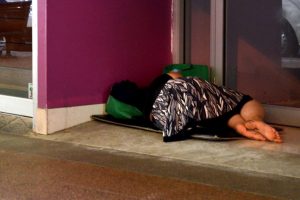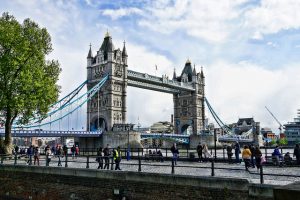
It’s been a while since we had a dog underfoot and this one specialises in getting as underfoot as possible. If not that, he’ll be in someone’s lap – a 22.5 kg lap dog.
When I take Dog for a walk up the main street he gets sooked-over big time- “Aw what a cute Staffie – is he friendly?” Well, he does have a green harness and lead with “friendly” emblazoned upon it, so, yeh. We are just baby-sitting this one, and I use the word advisedly as he is an anxious dog who (a) does not like to be outside when all the humans are inside, and (b) dislikes being left alone for more than two or three hours. This makes a weekend trip to Brisbane for the ballet just a bit tricky.
He’ll lie doggo on the back seat of the car for a lengthy time but then starts whining and the whining turns into screaming. Oh, you know this behaviour? The other thing Staffies do is a supressed excitement grunt not unlike Marge Simpson’s hhmmnn (when Homer is being irritating).
On Wednesday night Dog was in his element – a choice of laps to sit in with the ritual watching of the State of Origin. He got excited and confused with all the yelling and cheering in the 78th minute. Last time (when Queensland was beaten), we made him wear a maroon beanie and put photos on Facebook.
If you inhabit Facebook you will see a lot of dog photos (and videos) including one that had 17 million views.
The obvious question is who watched these videos and why? Other dog owners, I’m guessing.
The RSPCA says there are 4.5 million dogs in Australia, with 39% of households having one.
Dogs in Australia experience lifestyles ranging from the cossetted fur babies who have the run of the house, their own beds (usually at the foot of the humans’ bed), pet insurance, gourmet pet food and the vet on speed-dial. In the middle are working dogs; guiding disabled people, sniffing out drugs or explosives, guarding junk yards, tracking bad guys, herding sheep, baling up pigs or hunting down rabbits. At the other end of the scale are the neglected dogs, chained up all day while the owners are away and often abandoned once their owners realise how much work is involved.
Many ‘rescue’ organisations have been formed to take neglected dogs away from bad circumstances, to rehabilitate them and foster them to caring families. One such foster-Dad was telling me his rescue dog flinches whenever someone nearby swears loudly. So dogs get PTSD too.
We could have a lengthy debate about dogs and their respective levels of intelligence. German Shepherds are said to have the intellect of a seven-year-old child. One night we were watching Inspector Rex (remember Rex?) on our big screen TV, positioned against a lounge room wall with our bedroom on the other side. Previously we had thought our female Alsatian was uninterested in TV. But then Rex appeared and went ‘woof’. Our dog scampered behind the TV, then into our bedroom and came out a few seconds later with a perplexed look.
Smart dogs come when called
The difference between the German shepherd and the Staffie is the latter will come when called. Our Shepherd would spot some other dog on the other side of the park and off she’d go (at pace), coming back when she felt like it. She was too smart to try crossing Annerley Road on her own, but too dumb to open the side gate once she did come home.
She Who Takes Dog Photos has, among her many interests, a knack for identifying dog breeds. She did this repeatedly on our travels, in the US, Canada, the UK and various parts of Europe. (One time, after a few moments of disbelief, I said “Get away, there’s no such dog as a Dandie Dinmont”)
I had to bow to her encyclopaedic knowledge of dog breeds. On the surface, this is a fairly useless skill. But you can start conversations with complete strangers and some of them may end up giving you directions or sharing lunch on a train (Italians take their dogs on trains).
Unfortunately, dogs go in and out of fashion. Teenagers (‘I want a puppy’), will pick whatever type of dog their peer group likes at the time – (Rottweilers r cool!) Older people, perhaps influenced by popular media, want a dog like the one Madonna has, or Prince Harry. Back in the 60s and 70s, Afghan hounds were popular, then Irish setters, breeds known for shedding and for not having much between their ears.
Many people buy or adopt a dog on a whim and quickly come to the conclusion that they are too much work. For the 61% of households who don’t own a dog, here’s what can happen if you give in to requests for a puppy.
According to the BankWest Family Pooch Index, it can cost $25,000 to look after a dog over its lifetime. Some dogs die young, through accidents, ticks, genetic flaws or terminal illness. Most, however, will soldier on to reach the life expectancy of the relevant breed. An old poodle, part of our extended family, turned 18 the other day. He has a few ailments we humans share like cataracts, hearing loss, spinal degeneration and hip problems. But he knows what he wants. Yarp means he wants to go out. Yipe means he wants to come back in. Warf means “I want to come up the back steps but I can’t so could you please carry me?”
If you’ve never owned a dog, remember these important points:
- Dogs lack opposable thumbs, so you need to do everything for them that humans use their hands to accomplish;
- Female dogs which are not desexed can have up to 15 puppies at a time; said puppies at three months’ old will be consuming two to three kilograms of meat per day; finding good homes for them will be problematic
- Dogs left alone while you are at work commonly bark and give your neighbours the shits; if you buy a companion for the first dog, you could end up with two dogs barking all day;
- Teenagers say they want a puppy but then, when they get a boy or girl friend, will leave said puppy in your tender care;
- If you want to travel, there are only three options: a dog and/or house sitter, a kennel or the dog goes with you.
When we travelled around Australia in 2015, it seemed every second caravanner had at least one dog. These people frequently use free camps because so many caravan parks have a ‘no dogs’ rule. We said hello to a couple travelling in a Toyota Hiace pop-top motor home. They showed us their set-up – two single beds and a dog bed in between for their Labrador!
Once at a free camp (there was only one other van when we arrived) I approached a dog. The owner, who was sitting in a camp chair reading a caravan magazine, said “Don’t pat him when he’s chained up. He’s on guard duty.”
Nice doggy – sit, stay.
I’m joining in a St Vinnies fundraiser for homelessness next Thursday (29th). There are some 1500 homeless men, women and children on the Sunshine Coast, including some in our small town. I hope you can help meet my target of $500 (the regional target is $100k). Think of me and 80+ others next Thursday, with our sheets of cardboard, soup and rolls and (hopefully adequate) sleeping bags.
Here are links to articles I have written previously on this topic
http://bobwords.com.au/homeless-for-a-week/
http://bobwords.com.au/everyone-should-have-a-home/
http://bobwords.com.au/goodwill-housing/
http://bobwords.com.au/little-bit-compassion/
Thanks for your support.









